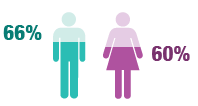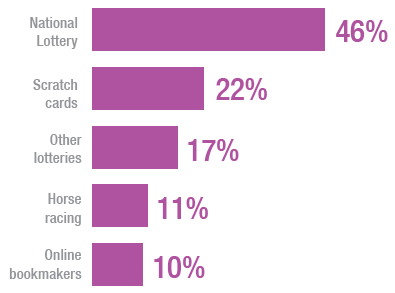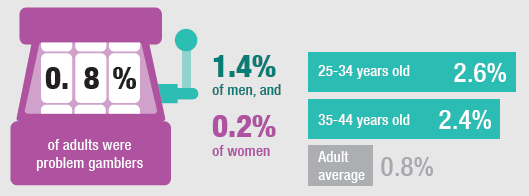Scottish Health Survey 2017: summary report
Key findings from the Scottish Health Survey 2017 report.
This document is part of a collection
Chapter 9: Gambling
6 in 10 (63%) adults had gambled in last 12 months
Men were more likely to have gambled than women

Most popular gambling activities

- In 2017 adults took part in an average of 1.5 gambling activities in the past year.
- Excluding the National Lottery completely, 12% of all adults had participated in online gambling, with men more likely than women to do so (18% of men, 6% of women).
- Men took part in a wider range of activities than women; of the 19 different gambling activities 7 were undertaken by more than 10% of men whereas only 3 different gambling activities were undertaken by over 10% of women.
- Overall, more than 1 in 10 (12%) adults participated in four or more gambling activities in the last year with men more likely to do so (17% of men compared with 7% of women).
- The youngest and oldest age groups had the lowest gambling participation rates (51% of those aged 16-24 and 44% of those aged 75 and over) with participation highest among those aged 45-54 (73%). This pattern was largely influenced by national lottery only gambling – once this is excluded gambling activity was at its highest for those aged 25-34 (58%), gradually decreasing to 25% among those aged 75 and over.
- Adult gambling activity participation decreased from 70% in 2012 to 63% in 2017; largely driven by a decrease in National Lottery participation from 58% in 2012 to 46% in 2017.
Problem gambling was particularly high among younger men

- Prevalence of problem gambling was lowest among men aged 65-74 (0.2%). For women aged 16-24 and 45 and over there were no cases of problem gamblers among survey participants.
- Adults with a GHQ-12 score of 4 or more (indicative of a possible psychiatric disorder) were more likely to be classed as a problem gambler according to the DSM-IV scale than those with a GHQ-12 score of 0 (1.7% for those with a score of 4 or more compared to 0.3 for those with a score of 0). This association was particularly evident for men – 3.4% of men with a GHQ-12 score of 4 or more were identified as problem gamblers compared with 0.6% for those with a score of 0.

were identified as problem gamblers
Contact
There is a problem
Thanks for your feedback